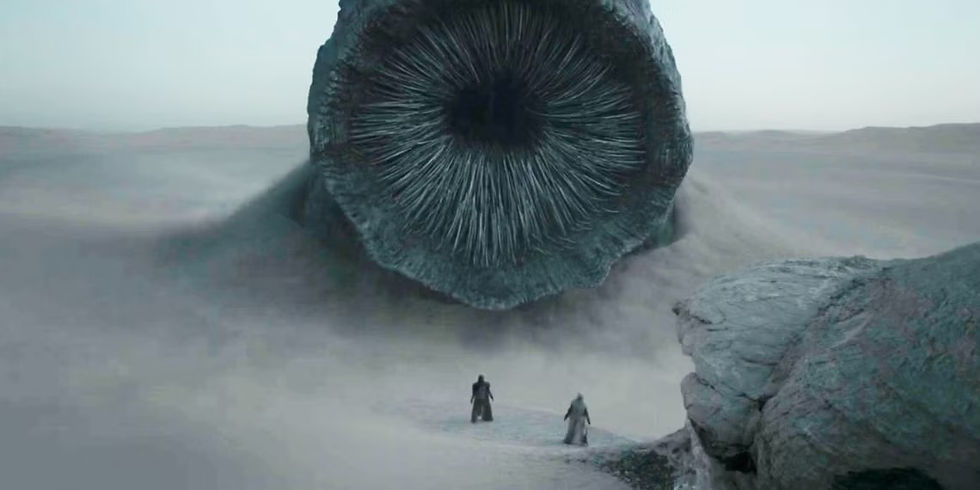The Spirituality of Dune
- Scott Barnard

- Jul 15, 2025
- 4 min read
Updated: Jul 22, 2025
Dune: Part Two — Enchanted Ecology and the Spiritual Universe

Denis Villeneuve’s Dune: Part Two (2024) continues the spiritual journey begun in Part One, but with greater intimacy and transcendence. Where the first film established the brutal logic of survival on Arrakis, the second delves into what it means to belong to a world not through control but through reverence. The desert is no longer Paul’s adversary, it becomes his teacher and ultimately, his source of spirituality. Villeneuve crafts a beautiful cinematic universe that not only reflects Frank Herbert’s ecological warnings, but re-enchants them, presenting Arrakis as a sacred system in which every grain of sand, every drop of water, and every ritual action carries layered meaning about spiritual connection and about belonging. Through expansive cinematography, mythic sound design, and symbolic codes, Dune: Part Two extends beyond the more obvious political themes into a meditation on humanity’s place in a living, sacred universe.
Visually, Villeneuve presents an aesthetic contrast between industrial oppression and sustainable ecology and spirituality. The Harkonnens are portrayed as parasitic, mechanistic and brutal. Their world is industrial and void of wonder. In contrast, the Fremen are shown with intimate warmth: soft candlelight in sietch chambers, dust-choked sunrises over sand dunes, and the spiritual silence of the open desert. Sound designer, Richard King, deserves his Oscar win for his work here because he’s captured one of the few spiritual moments I’ve experienced in my life, in this case it was my time in Death Valley and experiencing a silence so powerful it engulfed me into its nothingness leading to a spiritual transcendent moment. Australian cinematographer, Greig Fraser, uses wide shots and shallow focus to highlight the scale and mystery of the desert, reinforcing its symbolic power and that overwhelming experience of awe one has while in one of Earth’s beautiful deserts. This tension Dune: Part Two has between sterility and sacredness speaks to a deeper philosophical divide: the mechanistic universe of domination versus the enchanted universe of participation. Paul’s spiritual transformation across Part Two hinges on this shift - he moves from viewing the desert as terrain to understanding it as a living entity governed by meaningful ecology and a place of spiritual connection. This mirrors the worldview found in films like Princess Mononoke (1997) where nature is not inert matter but a moral force with its own will, or Australian Aboriginal spiritual beliefs where they are one and the same with the land.

Spiritual culture in Dune: Part Two is represented through Fremen rituals from water harvesting to the ceremonial taming of the sandworm, which are acts of reverence and survival simultaneously. The moment Paul rides the sandworm is not framed as a triumph of conquer, rather it communicates his communion with the desert and is symbolic of his surrender to it. Zimmer’s score deepens this connection with throat singing and choral laments, pulling the audience into a sacred sonic experience.

The ecological themes of Dune: Part Two are intensified through the Fremen’s dream of transforming Arrakis into a lush, green world. This vision of environmental rebirth is both beautiful and tragic, as it risks destroying the very system that gave rise to the Fremen’s culture and resilience. Liet-Kynes’ earlier warnings in Part One echo here: to change the ecology of Arrakis is to change its soul. Villeneuve asks the audience to consider whether paradise is worth the loss of spiritual connection to a harsh, sacred world. He portrays nature as something to be understood, adapted to, and ultimately revered. In a time of climate crisis and ecological collapse, where we’ve had about 400,000 animals go extinct in the last few hundred years, Dune functions as both cautionary tale and sacred myth. It reminds viewers that the environment is not merely a resource but a force with agency and that to survive, we must learn to listen, Dune also shows us a spiritual path to connect with something greater than ourselves.

One of the most powerful emotional through-lines in Dune: Part Two is its cultivation of awe not merely as spectacle but as a bridge between perception and spirituality. Villeneuve’s mastery of scale, silence, and space allows the audience to feel the immensity of Arrakis: the infinite sand dunes, the titanic sandworms, the ancient stillness of the desert night. These moments are not only beautiful they overwhelm the senses creating a visceral experience of wonder. This sense of awe becomes a gateway to spiritual reflection, both for Paul and for the audience. When Paul rides the sandworm for the first time, the camera pulls back not to glorify him, but to show how small he is within the vast living system he has submitted to. In this way, Villeneuve’s visuals do more than represent awe, they evoke it, and in doing so, prepare the viewer to feel spiritually reconnected to nature in their own lives. It’s a cinematic invitation to see the Earth not just as material, but as mystery. Awe, then, is not incidental, it is the emotional key that unlocks the film’s sacred ecology.

In conclusion, Dune: Part Two elevates the franchise’s ecological and spiritual themes by presenting Arrakis not just as a setting, but as a sacred system with its own rhythms, limits, and meanings. Through immersive cinematography, symbolic sound design, and mythic narrative structures, Villeneuve constructs a cinematic universe in which nature is not conquered, but worshipped. The film critiques imperialism, industrialism, and religious manipulation yet never loses its sense of awe. It is science fiction that re-enchants the world, reminding us that even in a deterministic universe, there is mystery, agency, and meaning. And for me, Dune makes me want to explore another great desert and hopefully have another spiritual experience.


